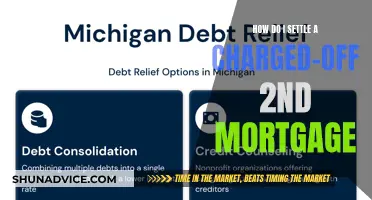
Removing a spouse's name from a mortgage is a complex process that often arises in the event of a divorce or separation. While refinancing is the most common method, it is not the only way to remove a name from a mortgage. This involves obtaining a new mortgage in the name of the person retaining ownership of the property, which pays off the existing mortgage and releases the other party from their obligation. However, refinancing may result in additional closing costs and the potential challenge of qualifying for a new loan. Alternative options include loan assumption and loan modification, although not all lenders allow these. In the case of loan assumption, one party takes over full responsibility for the mortgage with the lender's approval, while loan modification involves the lender agreeing to alter the terms of the existing loan. Ultimately, the decision to remove a name from a mortgage depends on various financial factors and the lender's approval.
How to remove a name from a mortgage:
| Characteristics | Values |
|---|---|
| Refinancing | The most common method to remove someone from a mortgage is to refinance the loan in the name of the person retaining ownership of the property. This involves obtaining a new mortgage that pays off the existing one, releasing the other party from their obligation. However, this comes with additional closing costs and the potential challenge of qualifying for a new loan. |
| Loan assumption | One party takes over full responsibility for the mortgage with the lender's approval. This is not always available and depends on the original loan terms and lender policies. It is not a free process and can cost 1% of the loan amount plus administrative fees. |
| Loan modification | The lender agrees to alter the terms of the existing loan to accommodate the change in borrowers. |
| Bankruptcy | If the person whose name is to be removed from the mortgage declares bankruptcy, their debts, including mortgage debt, are discharged, meaning they no longer have to pay them. |
| Release of liability | A document that releases a borrower from their obligation to pay back the loan. The remaining spouse needs to qualify for the new loan using only their income and assets. |
| Quitclaim deed | A document used to voluntarily give up one's ownership rights. |
What You'll Learn

Refinancing the mortgage
Refinancing a mortgage is a good way to divide up property and remove one party's name from the mortgage. It involves obtaining a new mortgage that pays off the existing one, releasing the other party from their obligation. However, it does not automatically remove the ex-spouse's name from the house title. The remaining spouse will need to qualify for the new loan using only their income and assets.
The refinancing process is similar to the original mortgage application process, requiring proof of income, credit history, and outstanding debts. The individual's income must be high enough to convince the lender of their ability to make the mortgage payments alone. A credit score of roughly 740 or higher is also necessary to secure a reasonable interest rate.
Mortgage assumption is another option, where one party takes over full responsibility for the mortgage with the lender's approval. This is not always available and depends on the original loan terms and lender policies. It is also not free and can cost 1% of the loan amount plus administrative fees.
A loan modification is a third option, where the lender agrees to alter the terms of the existing loan to accommodate the change in borrowers. This option does not require refinancing, but it is usually only allowed in cases of financial hardship, and the lender may demand evidence that the remaining borrower can afford the payments.
If refinancing is not possible due to financial constraints, credit issues, or lender restrictions, selling the property might be the only solution to remove the obligation from both parties.
Paying Off Your Mortgage Faster: Strategies for Success
You may want to see also

Loan assumption
If you want to remove your husband's name from the mortgage, one option is to refinance the loan in your name. However, if refinancing is not possible due to financial constraints, credit issues, or lender restrictions, you may want to consider a loan assumption.
There are two distinct ways to assume a mortgage: novation and simple assumption. Novation is the safest type, as the lender agrees to let the buyer take responsibility for the existing mortgage. The lender puts the buyer through the underwriting process before giving its approval and releases the seller from all future responsibility for the mortgage payments. Simple assumption is a private transfer of responsibility for the mortgage from the seller to the buyer without the mortgage lender's approval. This is a much riskier transaction because the buyer has not been vetted by the lender.
Mortgage assumption can be a valuable option if you're looking for a lower interest rate and want to simplify the home-buying process. However, it's important to note that not all lenders allow loan assumptions, and there may be fees associated with the process. Additionally, removing someone from the mortgage doesn't automatically strip them of ownership rights. To give up their rights, your husband will likely have to file a quitclaim deed.
Removing Your Ex-Husband from Your Mortgage: A Step-by-Step Guide
You may want to see also

Loan modification
Removing a name from a mortgage is not a simple process, but it is possible. The most common method is to refinance the mortgage in one person's name. This involves applying for a new loan with a new set of terms, based on that individual's finances. However, this may not be a viable option for those who do not qualify for a new loan based on their income and credit profile.
In this case, a loan modification may be an option. A loan modification is where the lender agrees to alter the terms of the existing loan to accommodate the change in borrowers. The specific terms of a loan, such as its interest rate or length of repayment, can be changed without refinancing. This option is usually only granted in cases of financial hardship, but some lenders may accept divorce or legal separation as a valid reason for a loan modification. It is important to note that not all lenders offer loan modifications, so it is essential to consult your lender to understand their policies and negotiate if possible.
Loan assumption is another alternative, where one party takes over full responsibility for the mortgage with the lender's approval. This option does not require refinancing, but it is not widely available, and there are closing costs involved. Lenders may be hesitant to agree to a loan assumption because it transfers the responsibility of the loan from two borrowers to one, increasing their risk.
If you are the spouse remaining on the mortgage, you will need to qualify for the loan using only your income and assets. It is also recommended to obtain a release of liability from the lender, which eliminates your obligation to repay the loan if your ex-spouse fails to do so. This option is not guaranteed and may come with associated fees.
Finally, if all other options are exhausted, selling the property may be the only solution to remove the obligation from both parties.
It is always a good idea to consult a lawyer when navigating this complex process. They can provide expert guidance and help you understand your options and rights.
Paying Off Your Mortgage: Strategies for Financial Freedom
You may want to see also

Release of liability
Removing your husband's name from the mortgage is possible, but it can be a complex process. The most common method is to refinance the loan in your name only, but this is not the only way.
Firstly, it is important to understand the difference between removing a name from a mortgage and removing someone's ownership rights. If two names are on the mortgage, both parties are responsible for repaying the loan. However, it is the names on the promissory note that determine legal ownership of the home.
If you are considering refinancing to remove a name from your mortgage, you will need to qualify for the mortgage alone. Contact your lender to discuss your options, which may include refinancing or obtaining a release of liability. Specific steps vary by lender, so consult your loan officer for guidance.
A release of liability will eliminate your husband's obligation to repay the loan if you fail to do so. However, many lenders won't agree to a loan assumption, and those that do may demand evidence that you can afford the payments. A loan assumption isn't free and can cost 1% of the loan amount plus administrative fees of $250 to $500.
If you are unable to refinance, the lender might insist that you fully pay off the loan to take your husband's name off the mortgage. This action will finalize the loan, freeing you and your husband from the mortgage agreement. If this is not possible, your only alternatives may be mortgage refinancing or selling the property to settle the remaining amount.
If your husband declares bankruptcy, his share of the mortgage debt could be discharged, meaning he would no longer have to pay it. This could work in your favour if your goal is to take sole ownership of the home without refinancing.
Another option is a loan modification, which allows you to change the terms of your mortgage loan without refinancing. This is usually only allowed in cases of financial hardship, but some lenders may accept divorce or legal separation as a reason.
If your husband is unwilling to cooperate in removing their name from the mortgage, you may be able to use a power of attorney to make decisions related to the property and the mortgage. However, this should be used cautiously and with legal guidance.
Finally, if neither borrower can afford the mortgage on their own, the only option may be to sell the home. This would remove both you and your husband from the home loan.
Removing an Ex-Spouse from a Joint Mortgage
You may want to see also

Quitclaim deed
Removing your husband's name from the mortgage is possible, but the most common method is refinancing the loan in your name alone. This involves obtaining a new mortgage in your name that pays off the existing one, thereby releasing your husband from their obligation. However, if refinancing isn't an option due to financial constraints, credit issues, or lender restrictions, there are alternative paths to consider.
One option is a loan assumption, where you take over the full responsibility of the mortgage with the lender's approval. This isn't always available and depends on the original loan terms and lender policies. Another option is a loan modification, where the lender agrees to alter the terms of the existing loan to accommodate the change in borrowers.
If you are looking to remove your husband's name from the property title as well, you will likely need a quitclaim deed. A quitclaim deed is a legal document that transfers a person's interest in a property to another party. It does not specify the nature of the person's ownership or rights in the property and provides no guarantees regarding the validity of those rights. In other words, a quitclaim deed simply releases the grantor (the person transferring the property interest) from any future claims of ownership over the property.
Because of the lack of warranty, quitclaim deeds should only be used under certain circumstances and are not recommended for traditional real estate sales. They are often used when a precise definition of the grantor's interest is unnecessary, such as when property is being transferred as a gift or to a family member. For example, a spouse may transfer their full interest in the marital home to their former partner as part of a divorce settlement using a quitclaim deed.
To transfer property using a quitclaim deed, a written form must be completed and may need to be notarized or acknowledged before a notary, depending on the state. Consult an attorney, especially one well-versed in family law, before making such a decision.
Purchasing Mortgage Leads: A Guide for Beginners
You may want to see also
Frequently asked questions
Removing a name from a mortgage is not a simple process. The most common method is to refinance the loan in your name alone, but this may not always be possible due to financial constraints, credit issues, or lender restrictions.
One option is a loan assumption, where you take over full responsibility for the mortgage with the lender's approval. Another option is a loan modification, where the lender agrees to alter the terms of the existing loan to accommodate the change in borrowers.
Removing your husband's name from the mortgage does not automatically remove his name from the house title or strip him of ownership rights. To do this, you will need to file a quitclaim deed, which surrenders all rights to the property.







